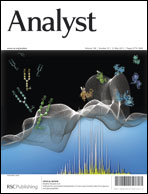Highly selective recovery of phosphopeptides using trypsin-assisted digestion of precipitated lanthanide–phosphoprotein complexes†
Abstract
The basic idea of this study was to recover phosphopeptides after trypsin-assisted digestion of precipitated phosphoproteins using trivalent lanthanide ions. In the first step, phosphoproteins were extracted from the protein solution by precipitation with La3+ and Ce3+ ions, forming stable pellets. Additionally, the precipitated lanthanide–phosphoprotein complexes were suspended and directly digested on-pellet using trypsin. Non-phosphorylated peptides were released into the supernatants by enzymatic cleavage and phosphopeptides remained bound on the precipitated pellet. Further washing steps improved the removal of non-phosphorylated peptides. For the recovery of phosphopeptides the precipitated pellets were dissolved in 3.7% hydrochloric acid. The performance of this method was evaluated by several experiments using MALDI-TOF MS measurements and delivered the highest selectivity for phosphopeptides. This can be explained by the overwhelming preference of lanthanides for binding to oxygen-containing anions such as phosphates. The developed enrichment method was evaluated with several types of biological samples, including fresh milk and egg white. The uniqueness and the main advantages of the presented approach are the enrichment on the protein-level and the recovery of phosphopeptides on the peptide-level. This allows much easier handling, as the number of molecules on the peptide level is unavoidably higher, by complicating every enrichment strategy.


 Please wait while we load your content...
Please wait while we load your content...